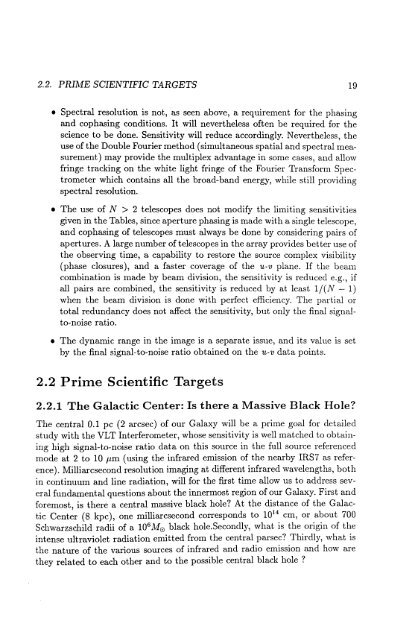The VLT Interferometer - ESO
The VLT Interferometer - ESO
The VLT Interferometer - ESO
Create successful ePaper yourself
Turn your PDF publications into a flip-book with our unique Google optimized e-Paper software.
2.2. PRIME SCIENTIFIC TARGETS 19<br />
• Spectral resolution is not, as seen above, a requirement for the phasing<br />
and cophasing conditions. It will nevertheless often be required for the<br />
science to be done. Sensitivity will reduce accordingly. Nevertheless, the<br />
use of the Double Fourier method (simultaneous spatial and spectral measurement)<br />
may provide the multiplex advantage in some cases, and allow<br />
fringe tracking on the white light fringe of the Fourier Transform Spectrometer<br />
which contains all the broad-band energy, while still providing<br />
spectral resolution.<br />
• <strong>The</strong> use of N > 2 telescopes does not modify the limiting sensitivities<br />
given in the Tables, since aperture phasing is made with a single telescope,<br />
and cophasing of telescopes must always be done by considering pairs of<br />
apertures. A large number of telescopes in the array provides better use of<br />
the observing time, a capability to restore the source complex visibility<br />
(phase closures), and a faster coverage of the u-v plane. If the beam<br />
combination is made by beam division, the sensitivity is reduced e.g., if<br />
all pairs are combined, the sensitivity is reduced by at least l/(N - 1)<br />
when the beam division is done with perfect efficiency. <strong>The</strong> partial or<br />
total redundancy does not affect the sensitivity, but only the final signalto-noise<br />
ratio.<br />
• <strong>The</strong> dynamic range in the image is a separate issue, and its value is set<br />
by the final signal-to-noise ratio obtained on the u-v data points.<br />
2.2 Prime Scientific Targets<br />
2.2.1 <strong>The</strong> Galactic Center: Is there a Massive Black Hole?<br />
<strong>The</strong> central 0.1 pc (2 arcsec) of our Galaxy will be a prime goal for detailed<br />
study with the <strong>VLT</strong> <strong>Interferometer</strong>, whose sensitivity is well matched to obtaining<br />
high signal-to-noise ratio data on this source in the full source referenced<br />
mode at 2 to 10 11m (using the infrared emission of the nearby IRS7 as reference).<br />
Milliarcsecond resolution imaging at different infrared wavelengths, both<br />
in continuum and line radiation, will for the first time allow us to address several<br />
fundamental questions about the innermost region of our Galaxy. First and<br />
,<br />
foremost is there a central massive black hole? At the distance of the Galac-<br />
tic Center (8 kpc), one milliarcsecond corresponds to 10 14 em, or about 700<br />
Schwarzschild radii of a 10 6 Mev black hole. Secondly, what is the origin of the<br />
intense ultraviolet radiation emitted from the central parsec? Thirdly, what is<br />
the nature of the various sources of infrared and radio emission and how are<br />
they related to each other and to the possible central black hole?

















